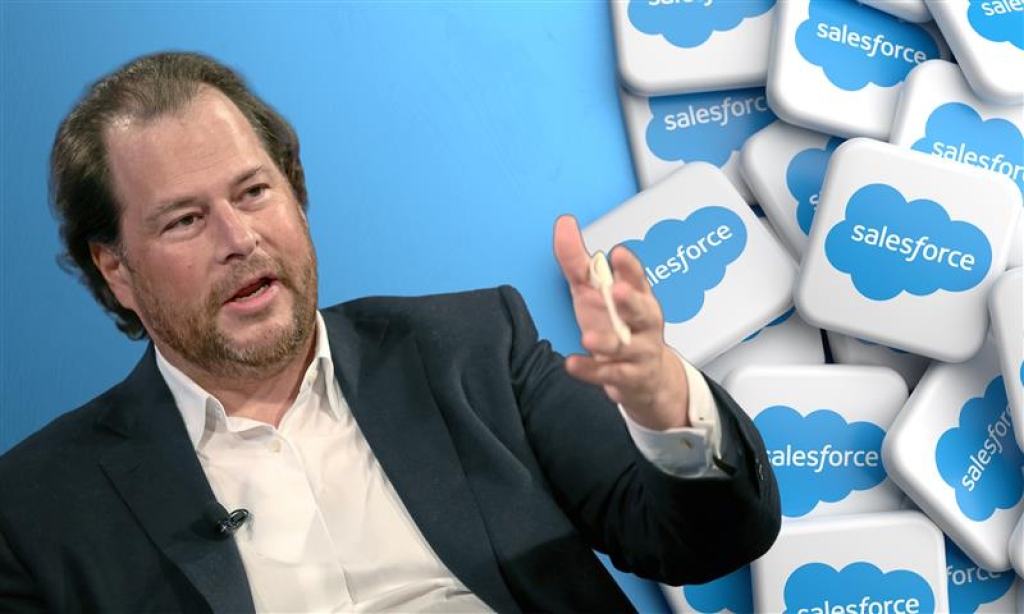

 Article
Article

 UVA Darden Professor Kimberly A. Whitler discusses the Enterprise Activism Risk Model, a framework for looking at activism through a lens of risk. Before making a public statement, she says, executives should ask: How unifying or polarizing is the issue? And how well does a stance fit with the firm’s mission and values?
UVA Darden Professor Kimberly A. Whitler discusses the Enterprise Activism Risk Model, a framework for looking at activism through a lens of risk. Before making a public statement, she says, executives should ask: How unifying or polarizing is the issue? And how well does a stance fit with the firm’s mission and values?

Insights from
Written by
It took just one sentence for Marc Benioff to turn his upcoming Dreamforce trip into a case study in corporate communication.
“We don’t have enough cops, so if they can be cops, I’m all for it,” the chair and CEO of Salesforce told the New York Times in October while en route to San Francisco.
His comment, backing President Donald Trump’s plan to deploy National Guard troops to the City by the Bay, triggered swift backlash from local officials and tech insiders, and prompted the CEO to apologize.
The blowback was a reminder that good intentions — in this case, public safety — aren’t enough in the age of CEO activism. It’s also the type of misstep that Professor Kimberly A. Whitler has studied closely.
“What we thought about activism 10 years ago is very different from what we think today,” says Whitler, the Frank M. Sands Sr. Professor of Business Administration at the University of Virginia's Darden School of Business. “It's one of the biggest reputational risks you can engage in, and it can create all sorts of inadvertent damage.”
Her recent paper, “The enterprise activism risk model: How good intentions can jeopardize business success,” written with Thomas Barta and highlighted in Harvard Business Review, offers a framework to help leaders think before they speak. It urges executives to weigh two questions: How divisive is the issue? And does our stance fit who we are as a company?
What Is Enterprise Activism?
The authors define Enterprise Activism broadly as “all forms of firm-initiated activism which can impact brand and business performance, such as brand activism, CEO activism, and corporate activism, regardless of who is making the decision or whether a portfolio brand or the corporate brand is involved.”
In other words, it covers everything from a CEO’s political tweet to a store manager’s community-level campaign if it influences how consumers perceive the brand.
“Enterprise Activism refers to firms taking action — regardless of the level of the individual initiating the action or the level of brand affected — to impact societal, political, economic, or environmental change,” they write.
The Two Axes of Risk
At the heart of Whitler and Barta’s model are two dimensions that determine how much risk an activism effort carries:
1. Consumer Agreement, or how much the target audience agrees with the stance; and
2. Positioning Alignment, or how well the stance fits with the brand’s established identity and purpose.
These axes form a cross model that sorts activism into four quadrants of escalating danger. As the authors note, “The consequences of low alignment are market share risk and/or positional advantage risk.” The sweet spot lies in the upper-right quadrant — where activism aligns tightly with both consumer sentiment and brand purpose. The bottom-left corner, by contrast, is the danger zone: low consumer agreement and low alignment.
In the case of Benioff’s comment about deploying the National Guard in San Francisco, Whitler notes that “on their website, Salesforce indicates that since 1999, they’ve had a singular focus, which is to help their customers improve their customer relationship.”
She adds, “How does a discussion about safety in San Francisco fit with that singular focus? It's not aligned with the core positioning of their product or company. And clearly there was consumer division on this.”
When Good Intentions Go Wrong
The paper uses several case studies to show how good intentions can jeopardize business success.
Nike’s 2018 Kaepernick campaign, for example, illustrates how divisive causes can fracture an audience. “By standing up for one side of a politically divisive issue, the Nike brand reduced its addressable market by alienating those who disagreed,” the authors write, citing survey data showing usage up among Democrats but down 24 percent among Republicans three years later.
Another example is Gillette’s 2019 “We Believe” campaign, which sought to challenge “toxic masculinity.” Whitler and Barta note that Gillette had long positioned itself as “the best shave a man can get,” a clear, product-centered promise. By shifting focus from shaving performance to male behavior, the company “redirected attention away from the products toward a focus on changing male behavior.” Sales declined, and the brand took a reputational hit.
These examples highlight the dual risks the authors identify:
- Market share risk, when a brand polarizes its consumers; and
- Positional advantage risk, when activism diverts time and resources from what the brand actually stands for.
As they write, “The longer an organization invests resources, time, and attention toward consumer-facing engagement that is divorced from their positioning, the greater the risk.”
Whitler explains that investing in activities that aren’t connected to a brand’s core positioning has two negative consequences.
First, it has an internal effect as it diverts resources away from activities that can strengthen the core positioning. Any attention that Disney’s CEO spent fighting the Florida “Parental Rights in Education Bill” or Elon Musk spent supporting conservative politicians is time spent away from building the business, she says. Now amplify this impact if it’s the board, the C-suite, and more employees diverted from core positioning efforts. Second, it has an external impact in that these activities dilute what a brand stands for in the minds of consumers.
“If Benioff is trying to create a brand that stands for improving customer relationships, how do messages about public safety relate and ultimately strengthen that brand image? Such unrelated comments can be confusing to customers and dilute brand perception,” Whitler says.
How to Use the Model
The Enterprise Activism Risk Model isn’t meant to discourage leaders from speaking out — it’s meant to help them do so with foresight so that they can minimize risk. The paper outlines five stages where executives can use the framework to “de-risk” decisions:
1. The design stage. At launch, founders can define how activism fits their mission. “Such thinking at the design stage can help insulate organizations from reactionary behavior later,” the authors write, citing Patagonia and Ben & Jerry’s as brands that built activism into their DNA.
2. The management stage. Established brands can use the model to test whether a proposed stance fits their strategy. Sainsbury’s CMO Mark Given told the authors it’s particularly useful for long-term brand positioning strategy and planning.
3. The crisis stage. When public pressure mounts, the model helps leaders stay rational. Julie Daum, Darden’s CMCO, described its value as “a simple framework that provides a logic” to help guide CMOs through a decision. The simple model “helps remove the emotion and focus the team on minimizing risk.”
4. The C-suite stage. Former Coca-Cola chief marketing and commercial officer Joe Tripodi emphasized that “marketing has the potential to be hijacked… by people who are deeply focused on causes.” The model, he said, “shifts the conversation away from the person advocating for the cause and reorients it to where it should be — on the consumer, brand and business.”
5. Beyond activism. The same logic can apply to sponsorships, partnerships, or any leadership choice that carries reputational trade-offs. As executive-search leader Christine DeYoung put it, “Every leader should have this laminated on their desk… Where am I spending my time as a leader?”
The Takeaway
For Whitler, the bottom line is not that executives should stay silent — it’s that they should be deliberate. The Enterprise Activism Risk Model gives leaders a way to “evaluate, discuss, and navigate activism to minimize business risk.”
Professor Kimberly A. Whitler is co-author of “The enterprise activism risk model: How good intentions can jeopardize business success,” with Thomas Barta, published in the Journal of Retailing (2024). See also: “Reducing the Risks of Corporate Activism,” published by Harvard Business Review in the magazine issue Nov-Dec 2024.
Whitler is an authority on marketing, with expertise in marketing strategy, brand management, and marketing performance. Her research centers on understanding how a firm’s marketing performance is affected by its C-suite and board.
A prolific writer as well as researcher, Whitler has authored nearly 100 articles related to C-level marketing management challenges and is a contributor for Forbes and CMO.com. Social Media Marketing Magazine named her one of the Top 100 Marketing Professors on Twitter.
Whitler has held leadership roles, including GM and CMO positions, within the consumer packaged goods and retailing industries, including Procter & Gamble, David’s Bridal and PetSmart. She has helped build $1B+ brands, including Tide, Bounce, Downy and Zest.
B.A., Eureka College; MBA, University of Arizona Eller School of Business; M.S., Ph.D., Indiana University Kelley School of Business